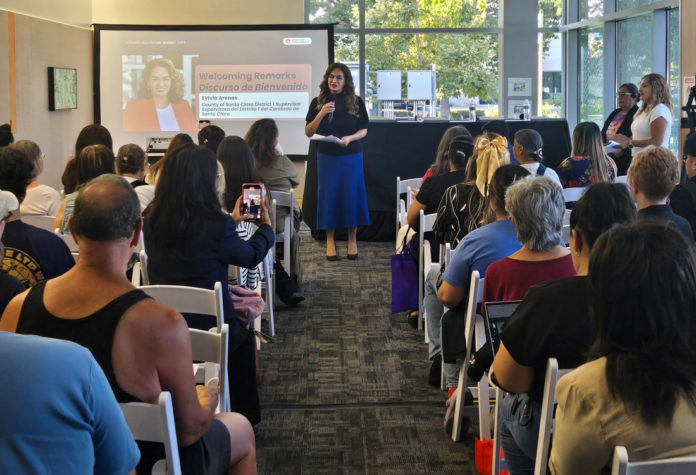Santa Clara County officials and partnering nonprofits convened an emergency townhall meeting in South County Friday to warn residents about potential impacts from recently passed federal legislation that could slash healthcare funding and force difficult choices for local services.
The meeting at the Valley Health Center in Gilroy addressed the financial impacts of the recently passed federal bill H.R. 1, dubbed the “One, Big, Beautiful Bill Act,” which county officials say represents an unprecedented cut to federal support for healthcare and social services.
“This represents a tear in the services and the system that we are hoping and counting on providing you each and every day,” said Sylvia Arenas, Santa Clara County District 1 Supervisor.
The meeting occurred as the county aims to convince voters in November to approve a new five-eights cent sales tax that supervisors recently approved for placement on the ballot.
James Williams, Santa Clara County Executive, said the county faces losing more than $1 billion annually in federal revenue for its health and food services. MediCal represents more than 50% of revenue for the county’s health system.
“We’ve had the most critical funding stream for access to these core healthcare services ripped from us,” Williams said.
The impacts are expected to hit South County particularly hard. Arenas noted that three of the four communities with the highest percentage of MediCal enrollees are in South County: Gilroy with about 23,000 residents or 40% of the population; San Martin with 28% enrollment representing 2,000 people; and Morgan Hill with 40% of residents enrolled.
Williams emphasized the county health system’s crucial role in South County, where 50% of residents receive healthcare from the county and 75% of ambulance transports go to county hospitals, primarily Saint Louise Regional Hospital, which the county saved from bankruptcy.
“More than in any other part of Santa Clara County, Santa Clara Valley Healthcare is your healthcare delivery system, and there is not another healthcare delivery system,” Williams said.
The pressure on county facilities may increase as neighboring San Benito County announced this week that a private company had backed out of negotiations to purchase Hazel Hawkins Memorial Hospital. The public board that operates HHMH had been in negotiations with the company, Insight Health, since early this year.
Esther Peralez-Dieckmann, district chief of staff for Rep. Zoe Lofgren, said an estimated 300,000 people in Congressional District 18 rely on Medicaid, and statewide, 17 million people could lose healthcare coverage.
“That wave of people is going to hit us very quickly,” Peralez-Dieckmann said.
To offset the federal cuts, county supervisors unanimously approved placing Measure A, a five-eighths cent sales tax measure on the upcoming November ballot. The sales tax would last five years and generate an estimated $330 million annually to help keep services stable while healthcare advocates fight to reestablish federal funding. Lofgren has endorsed the measure, according to her staff.
“There is not a more critical time for a tax measure to support what is coming,” Peralez-Dieckmann said.
County officials stressed their commitment to maintaining services despite the challenges. Williams said the county will “fight for what we have here” rather than simply accept federal cuts that would “wreak devastation for our community.”
Community member Sharon Luna raised concerns about hospital accountability and management, questioning whether proper audits are in place to prevent over-billing and ensure efficient operations.
“I would be glad to pay a tax, however I need to know that the hospitals are being managed accordingly,” she said, citing a 2024 controversy in which the Oroville Hospital, a privately owned hospital in Oroville, California, was found to be incentivizing unnecessary admissions and over-billing Medicare and MediCal patients to increase revenue.
Paul E. Lorenz, Santa Clara Valley Healthcare CEO, emphasized the transparency of the public hospital system compared to private facilities like Oroville.
“There is no hospital that is as transparent as our hospital,” Lorenz said, noting that all financial reports, budgets and performance data are published monthly and available to the public.
Williams added that county employees receive no incentive pay based on profit, contrasting with private healthcare systems where “tremendous amounts of incentive payments” are profit-based.
The county health system includes nationally recognized facilities, such as the No. 7 ranked trauma center for rehabilitation and one of only three burn centers between Los Angeles and Oregon.
Officials urged residents to stay engaged and informed as the county works to preserve healthcare access amid the federal funding cuts. The meeting was hosted by the “Defend Our Care” Coalition.
“We want to make sure that we continue to hold stable,” Arenas said. “This is a system they can always count on.”















That’s a nice hospital there in Gilroy. It would be a shame if something happened to it!
Seriously: Santa Clara County can do what the rest of us have to do. Figure out how to make ends meet, with what we have.
I urge a vote against the proposed sales tax increase.
Federal funding for illegals is slashed so now we need to pay for it, got it!